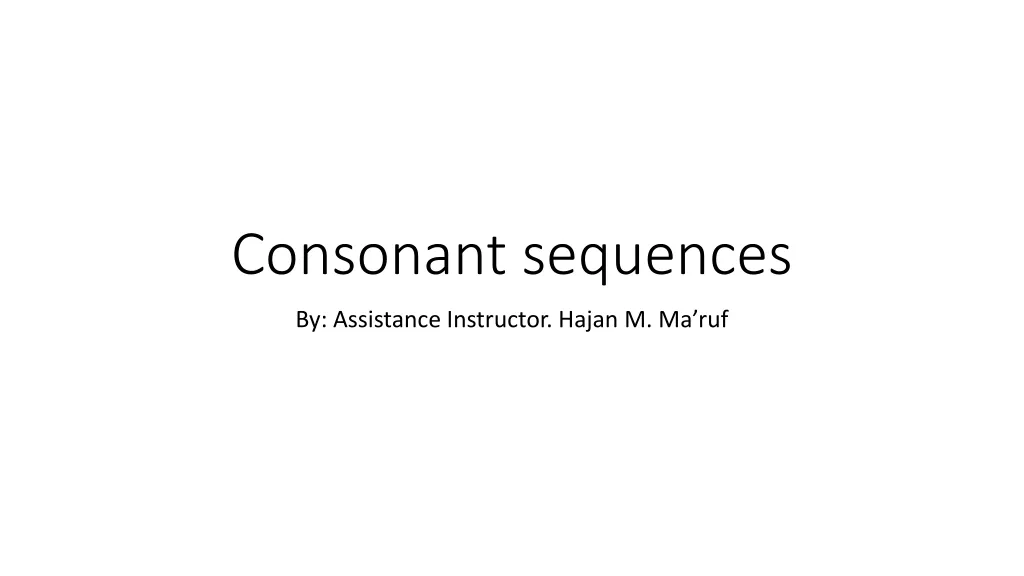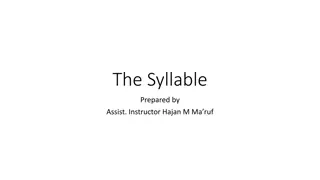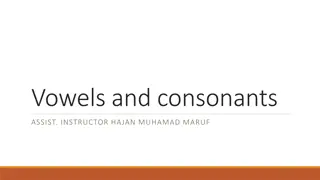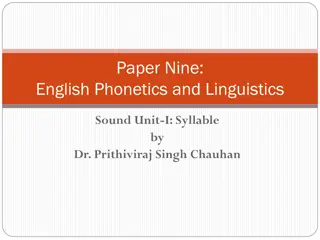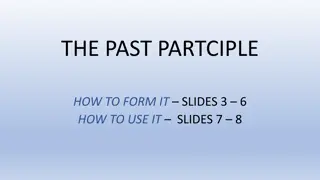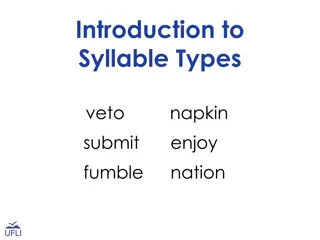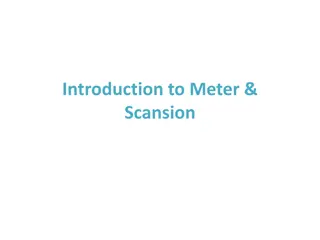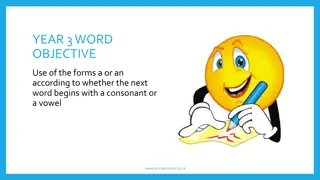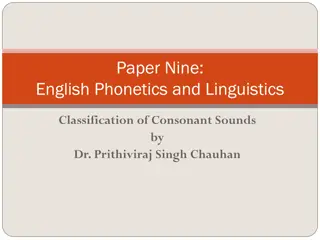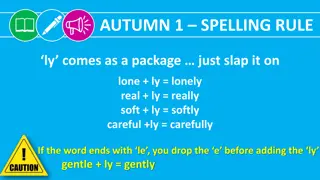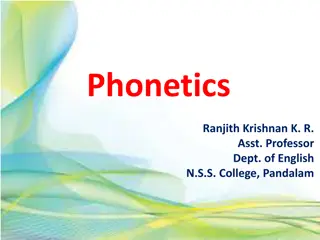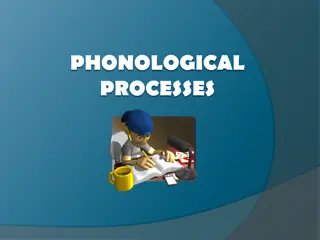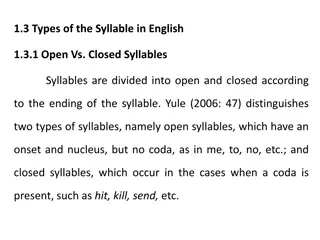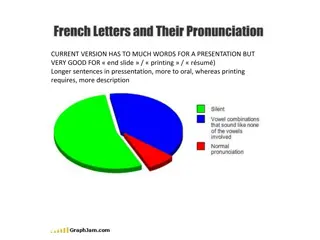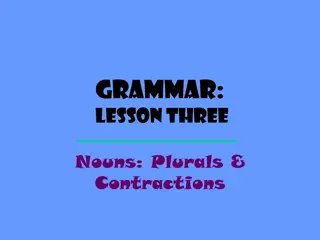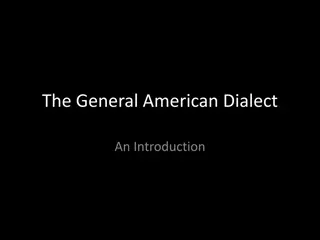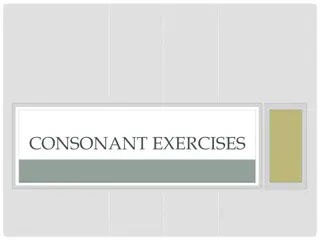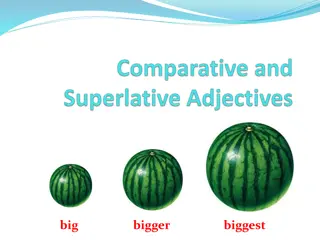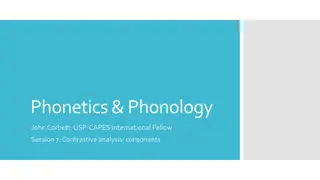Consonant Clusters in English
Consonant clusters are groups of consonants without vowels in between, found at the beginning, middle, or end of words. They play a crucial role in English pronunciation and word formation, with specific patterns and exceptions to consider. This guide provides insights into different types of conson
3 views • 18 slides
The Importance and Nature of Syllables
Syllables play a crucial role in speech rhythm, yet their definition and identification can vary among individuals. The nature of syllables, encompassing vowels, consonants, onsets, and codas, can be analyzed phonetically and phonologically. This article explores syllable structures and phonotactics
2 views • 18 slides
Vowels and Consonants in English Language
The English alphabet consists of 26 letters, with 5 vowels (A, E, I, O, U) and 21 consonants. Vowels are unique sounds produced by opening the mouth without obstructions, while consonants involve partial or complete closure of airflow. Vowels can be further categorized into long and short based on t
6 views • 28 slides
English Syllables: Phonetics and Linguistics Insights
Explore the concept of syllables in English phonetics and linguistics, learning about syllable formation, examples of mono and disyllabic words, and the role of vowels and consonants in syllable structure. Delve into the essence of syllables as individual sound units within words. Discover more thro
14 views • 8 slides
The Doubling Rule for Adding -ed and -ing Endings
Explore the rules for doubling consonants when adding -ed and -ing endings to words in English. This lesson provides clear examples and explanations to help you master this important aspect of grammar, leading to improved writing skills.
3 views • 81 slides
Mastering the Past Participle in English Verbs
Understand how to form and use the past participle in English verbs, both regular and irregular. Learn the rules for forming regular past participles, including when to double consonants and when to change 'y' to 'i'. Discover examples of irregular verbs and how their past participles are formed. Ex
0 views • 8 slides
Introduction to Syllable Types
Delve into the world of phonetics with this informative content explaining vowel sounds, consonant sounds, and the concept of syllables. Discover the differences between short and long vowel sounds, voiced and unvoiced consonants, and how syllable types can aid in pronunciation. Engage in interactiv
2 views • 31 slides
Medical Terminology: Key Components and Usage
Medical terminology is a specialized language used by healthcare professionals worldwide, rooted in Greek and Latin words. It comprises word parts, such as roots, prefixes, and suffixes, which are crucial for forming and understanding medical terms. The combining forms aid in pronunciation and help
4 views • 17 slides
Dactylic Hexameter in Latin Poetry
Latin poetry employs a rhythmic structure known as meter to enhance meaning and poetic effect. Particularly, dactylic hexameter is a prevalent meter in ancient epic poetry, consisting of six feet predominantly made up of dactyls—a long syllable followed by two short syllables. Scanning dactylic he
0 views • 9 slides
The Use of A and An in English Grammar
Explore the concept of using "a" or "an" in English based on whether the following word starts with a consonant or a vowel. Learn about consonants and vowels, practice identifying them, and see examples of correct usage. Enhance your grammar skills with this engaging educational material.
2 views • 13 slides
English Consonant Sounds: A Detailed Guide
This guide delves into the English phonetics and linguistics classification of consonant sounds, emphasizing factors such as place of articulation and manner of articulation. It covers various types of consonant sounds, from bilabial and labio-dental to alveolar, post-alveolar, palatal, velar, and g
1 views • 11 slides
Spelling Rules for Different Seasons
Learn essential spelling rules for autumn, spring, and summer with examples like adding -ly, i before e, dropping silent e, pluralizing y, and doubling consonants before suffixes. Enhance your spelling skills with these easy-to-follow guidelines.
1 views • 6 slides
English Pronunciation Class Activities and Examples
This class session covers various pronunciation activities and examples related to sibilant consonants, voiced and voiceless consonants, and conjugation patterns of verbs ending in -s, -z, -ch, -sh, -t sounds. It also includes exercises with verbs ending in -ed for pronunciation practice.
0 views • 6 slides
Guidelines for Forming Singular and Plural Nouns
This collection provides clear guidelines for forming singular and plural nouns, including adding "-s", "-y endings, and "-ies". It also covers exceptions, proper nouns, and tips on pluralizing certain words. Learn when to add "-es", double consonants, or when a false pronunciation might occur.
0 views • 21 slides
Phonetics: Sounds, Symbols, and Classification
Explore the world of phonetics with a focus on speech sounds, the International Phonetic Alphabet (IPA), organs of speech, and different types of phonetics including acoustic, auditory, and articulatory phonetics. Discover the unique characteristics of English sounds, vowels (monophthongs and diphth
2 views • 13 slides
Phonological Processes in English Language
Phonological processes involve changes in linguistic sounds over time, impacting language fluency and oral production significantly. EFL students can benefit from knowledge of these processes, like linking, gemination, elision, metathesis, assimilation, haplology, and coalescence, to enhance their l
1 views • 17 slides
Syllable Types in English Language
Syllables in English are categorized into open and closed syllables based on their endings. Open syllables have an onset and nucleus without a coda, while closed syllables include a coda. Additionally, syllables can be simple (with a vowel or single consonant) or complex (with consonant clusters). T
1 views • 6 slides
Irish Grammar: Past Tense Verbs - Rules and Examples
Learn about forming the past tense of 1-syllable broad verbs in Irish grammar. Understand when to use "h," "d," or "dh" before verbs starting with consonants, vowels, or "f." Discover how to ask questions and form negatives in the past tense, with helpful examples provided.
0 views • 6 slides
Study of English Phonetic Courses at University of Ben Boulaid Moustafa
Explore the world of English phonetics at University of Ben Boulaid Moustafa, Batna-2, Algeria. Delve into articulatory phonetics, phonology, consonants, vowels, diphthongs, triphthongs, and more. Understand the branches of phonetics and the physical production of speech sounds.
0 views • 49 slides
French Pronunciation Guide: Vowels, Nasal Sounds & Consonants
Explore the intricacies of French pronunciation through the International Phonetic Alphabet (IPA), understanding vowel sounds, nasal vowels, and consonant variations. Master the differences in sound production and learn how to correctly pronounce French words with detailed explanations and visual ai
2 views • 18 slides
Plural Nouns in English Grammar
Exploring the rules for forming plural nouns in English, from adding "s" to special cases like words ending in "s," "ch," "sh," "x," or "z." Learn how to modify nouns ending in vowels or consonants, as well as irregular plural forms and compound words. Enhance your grasp of English grammar with prac
0 views • 16 slides
Overview of the General American Dialect
The General American Dialect, also known as GenAm, is a widely preferred dialect of English characterized by minor differences in pronunciation compared to regional American accents. It is distinct from Southern, Midwestern, and Northeastern accents and is one of the two global English dialects alon
0 views • 13 slides
Phonetic Final Devoicing and Its Implications in Phonological Theory
Phonetic Final Obstruent Devoicing (FOD) challenges traditional phonological theories by presenting instances where devoicing cannot be purely phonological but must be phonetic in nature. This phenomena is evident in Proto- and Old French where word-final consonants devoice despite having intervocal
0 views • 30 slides
Simple Past Tense in English: Rules and Examples
The simple past tense is a fundamental form in Modern English used to describe past events. It involves regular verbs adding "-ed" and irregular verbs having different forms. The construction of the simple past helps distinguish it from other past tense forms like past perfect and past progressive.
1 views • 33 slides
Insights into Xhosa Language and Culture
Xhosa, the second most spoken language in South Africa, is part of the Nguni sub-family of the Bantu languages. It has a rich history, with various dialects and a unique structure based on noun classes and concords. The language has undergone significant transformations, such as being written in a R
0 views • 17 slides
Exploring the Unique Features of the Polish Language
Polish, a West Slavic language, boasts a distinctive alphabet with diacritics like ogonek and kreska. Nasalized vowels and palatal consonants set Polish apart, showcasing its rich linguistic heritage from Proto-Balto-Slavic to PIE roots.
0 views • 13 slides
Common Pronunciation Challenges in Spanish for English Speakers
Pronunciation challenges for English speakers learning Spanish include the addition of schwa sound, substitution of Spanish letters, confusion between /i/ and /ɪ/, omitting vowels before consonants, and issues with pronouncing /m/, /n/, and /r/. These challenges can affect the intelligibility and f
0 views • 11 slides
French H-Aspir, Glottal Stop, and Production Planning Domains
The research delves into the variability of the French "h aspir" phenomenon, which includes the presence of glottal stops and its impact on production planning. It discusses cases of both H-aspir-generated glottal stops and glottal stops occurring after unpronounced liaison consonants. The study she
0 views • 33 slides
Speech Signal Processing and Phonemes
Delve into the world of speech signal processing, exploring applications like speech storage, recognition, and synthesis. Discover how different languages utilize phonemes to convey meaning through various acoustic units. Uncover the intricacies of speech sampling and phoneme types, from vowels to c
0 views • 73 slides
Comprehensive Consonant Study Guide
Enhance your understanding of consonants with detailed exercises and reviews covering various features like voicing, place, and manner of articulation. Discover different consonant groups and common characteristics shared among specific sounds.
0 views • 8 slides
Comparatives and Superlatives of Adjectives: Rules and Examples
Learn how to form comparative and superlative forms of one-syllable and two-syllable adjectives, including rules for adding suffixes, doubling consonants, ending with "y", and irregular adjectives. Examples and images included for easy understanding.
0 views • 7 slides
Comparative Analysis of Consonants in English and Brazilian Portuguese
Explore the differences in consonant pronunciation between English and Brazilian Portuguese, focusing on minimal pairs and potential confusion points. The session covers various aspects such as vowel systems, phonological challenges, and accent nuances that may arise for Portuguese speakers when spe
0 views • 25 slides
Speech Rate Effects in Hindi Sounds System for Linguistics Research
Conducted by a first-year PhD student in Linguistics, this pre-dissertation research project focuses on the sounds system of Hindi speakers in Southeast/East Asia, particularly Indonesia. The research delves into sound production, perception, mental representation, and perceptual cues influenced by
0 views • 17 slides
Welcome to phonics with parents.
In phonics learning, children start in Nursery and the Early Years Foundation Stage (EYFS), utilizing this knowledge for reading and writing. Through active and engaging 20-minute daily lessons, children recap and learn new sounds, enhancing their decoding skills and reading confidence. The approach
0 views • 29 slides
